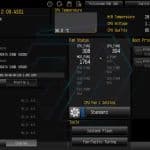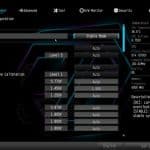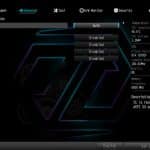Intel LGA1851 Socket & Z890 Chipset
It’s time for a new socket, the LGA1851. This means you must buy a new mainboard to use one of the latest Intel CPUs. You will have to spend a significant amount since, so far, only the top Intel Z890 chipset is available. More affordable chipsets and mainboards will be available in 2025.
The processor connects to the Z890 chipset through a DMI 4.0 x8 chipset bus (bandwidth comparable to PCI-Express 4.0 x8). It puts out 24x PCI-Express Gen 4x downstream lanes. This is a massive increase from the Z790, which has 16x Gen 4 and 8x Gen 3 lanes. The integrated USB complex consists of 32x USB 3.2 5 Gbps serial-deserializers, which motherboard designers can configure into 5x 20 Gbps ports, 10x 10 Gbps ports, and 10x 5 Gbps ports. There’s also a 14-port USB 2.0 hub. Intel has retired the HDA “Azalia” audio interface with Z890, which means onboard audio CODECs will have to use the newer MIPI SoundWire and USB 3.2 interfaces (which CODECs like the Realtek ALC4080 and ALC4082 already do).
The chipset integrates a 1 GbE MAC and Wi-Fi 6. Nonetheless, given the new chipset’s available PCIe and USB 3.2 connectivity, manufacturers can easily provide Wi-Fi 7 and 2.5 GbE ports (or better). They can also use Intel’s Killer networking package, which combines existing Intel networking PHY with the advanced Killer prioritization engine, and DoubleShot Pro, which works together to reduce network latency when gaming.
ASRock Z890 Taichi
This is a high-end mainboard, currently priced at $470. It is a beast of a mainboard equipped with Thunderbolt 4 Type-C ports (40 Gb/s), WiFi7, 5G, and 2.5G LAN ports, the Realtek ALC4082 Audio Codec, and the ES9219 SABRE DAC. Thanks to the bundled M. 2 expansion card, it also supports a ton of NVMe drives.
The four DDR5 slots support XMP profiles up to 9600 MT/s (OC Plus). Please note that 9600 MT/s applies to 1DCP (1 Rank) RAM. From power, the mainboard has highly capable voltage regulator modules featuring 24+2+1 (VCore/ VccGT/VccAUX) power phases. The VRMs utilize the Renesas RAA 229130 PWM controller and the R2209004 HBD (110A) power stages. Lastly, all capacitors are rated for 20K hours of operation, and their values range from 560uF to 1000uF. The increased capacity helps deliver smoothly the power required by the CPU and the rest of the mainboard.
The BIOS in the Advanced Mode is not for the inexperienced!




















































Thanks for the tests, but I don’t like how you completly ignore the timings on RAM. It’s a little less imporant than speed frequency but still makes a difference. Also you didn’t write if the memory works in Gear 2 (1:2) or Gear 4 (1:4) (especially important with AMD).
It all matters.
For example, DDR5-7200 CL34-42-42-84 (1:2) is faster than DDR5-9200 CL42-56-56-134 (1:4)
He is running 6000 c40! I’m sure ASRock really appreciates that. And comparing against 6000 c32, so what are we even testing here? The 8000 cas is kind a weird too I can’t find a kit what with those timings, the cheapest 8000 kit is cas 38. Anyway.
Your power testing is the only one I see that show the INTEL idle higher than AMD. I think most other sites just take the reported readings and not the actual. Some show INTEL cpu as idle only 4-5 watts, which I don’t think my laptop even can do. Ridiculous! Thank you for measuring the actual power consumption.
This website needs better software for commenting.
No formatting is possible, no line break, no whatsoever. Where is BBcode for example?
The text was written nicely and readable but is now posted as an unreadable pudding without dots and comma.
Oh man!
sorry we use the standard WordPress editor.
More than enough, what is important is the quality content offered by the website.
If I were an interested buyer, personally I would still wait 3 – 4 months for Intels’ “magic” bios and driver updatest to appear (which were publicly marketed weeks ago to fix performance and whatever).
Personally I would NOT buy at all, because there is still a HUGE red flag: Intel execs/marketing refuses to answer if this Arrow Lake is the only CPU generation on this socket.
No, a silly refresh in late 2025 with + 5 % performance does not count.
https://www.tomshardware.com/pc-components/cpus/massive-dell-blunder-leaks-intel-and-nvidias-mobile-roadmaps-nova-lake-panther-lake-cpus-and-genxx-gpus-listed
The Deall leak from this year shows that next-gen Nova Lake architecture will arrive Q4 2026/Q1 2027 and will bring a HUGE update for core count, performance and efficiency.
Both P-cores and E-core will be doubled = 16 + 32.
Other rumors this year (job descriptions) have shown Nova Lake will be the bigget jump since the core architecture 2006.
This is all in line with amd next huge leap which is Zen 6, which will abandon the low-performance, unefficient chiplet-crap introduced with Zen 2, togehter with the ancient crap technology copper wire bonding.
https://www.youtube.com/watch?v=ex_gPeWVAo0
Zen 5 is still stupidly overpriced and ancient crap packaging technology. Looking at pro-accelerators as MI300 and reading information on some forums, shows there will be big updates for modern packaging.
Core count is also now rumored to double.
If Intel execs/marketing continue to refuse to answer if Nova Lake will also come for this socket, buying Arrow Lake and this platform is a very very very unwise decision.
Thanks for testing.
Your power consumption tests are the real deal. I see some very different results compared to the other more mainstream testers.
Looks like peak- & average power consumption for both applications and gaming is still not good.
Also good to see you are testing games in 720p resolution. Lots of other testers still test 1080p + maximum graphic testing and don’t want to admit to themselves that in quite some new games even a rtx 4090 bottlenecks.
Critique and improvement proposal is that you don’t specify how you test the games; build-in benchmark or own custom scene= Do it like the testers at pcgameshardware and test with CPU-heavy custom scenes.
Drop the CringeBench 6 benchmark and for media encoding, please add AV01 codec (av1 format).
I would also like to see some power consumption tests for low-utilization applications; so far you only have tested the extreme, which is 100 % utilization. You also don’t specify which applications were used for that.
Another tests showing the E-core performance would be good. Also disabling E-cores and doing some performance tests.
Thanks and good luck.